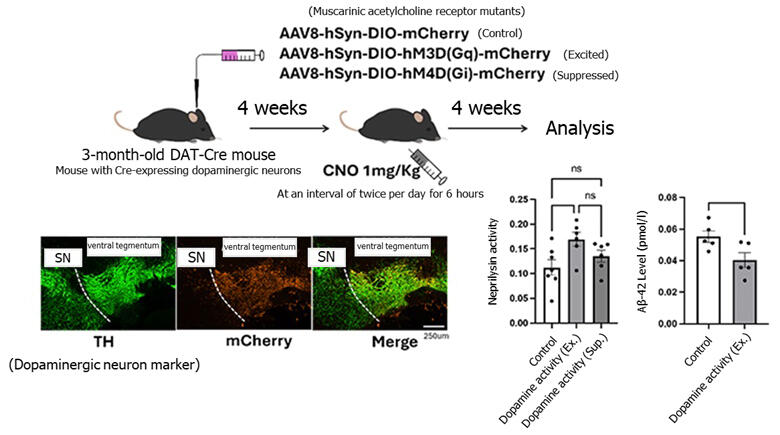An international research group led by Visiting Scientist Naoto Watamura (currently Junior Research Associate), Research Scientist Naomasa Kakiya (at the time of the study), and Laboratory Head Takaomi Saido of the Laboratory for Proteolytic Neuroscience at the RIKEN Center for Brain Science discovered that neprilysin, an enzyme degrading amyloid-β (Aβ) peptide, which is an early pathological factor in Alzheimer's disease (AD), is regulated by dopamine, a neurotransmitter in the brain. The results are expected to contribute to the development of prophylactic and therapeutic methods for AD. The study was published in Science Signaling.

Left: Schematic representation of the DREADD system, where Cre recombinase is used (top). Ventral tegmental cortex dopaminergic neurons selectively controlled activity (bottom). Right panel: increased neprilysin activity (left) and decreased Aβ42 levels (right) in the prefrontal cortex in a dopaminergic neuronal activity-dependent manner in the ventral tegmental cortex.
Provided by RIKEN
The research was conducted by the international research group to understand the mechanism of Aβ degradation in the brain and establish prophylactic and therapeutic methods based on this mechanism. Saido and his colleagues had previously shown that Aβ in the brain is mainly metabolized by neprilysin; somatostatin, a brain peptide, regulates neprilysin activity; and subtypes 1 and 4 of five somatostatin receptor subtypes mainly regulate neprilysin. They also showed that ENSA (α-endosulfine), an endogenous ligand for KATP channels, controls the neprilysin activity downstream of somatostatin receptors. However, these pathways primarily regulate the activity of neprilysin that exist locally in the hippocampus, and the mechanisms for its expression and activity regulation in the cerebral cortex remained unclear.
Through a comprehensive screening using cultured cells, the group initially found that dopamine was an activity regulator of neprilysin. They then observed that dopamine-exposed neurons reduced the amount of Aβ in the culture medium via neprilysin. Next, they used the DREADD system to examine the neprilysin expression and activity in the prefrontal cortex after long-term activation of dopaminergic neurons in the ventral tegmental area. The results showed that dopamine upregulated the expression and controlled the activity in an individual mouse.
Application of the DREADD system to AD model mice revealed that the quantity of Aβ deposits in the prefrontal cortex was reduced. Administration of the dopamine precursor levodopa (L-dopa), which is used for treatment of Parkinson's disease, increased neprilysin expression mainly in the prefrontal cortex and reduced Aβ deposits in AD model mice. It was also found that long-term administration of levodopa restored cognitive impairment.
Comparative analysis between young and aged wild-type mice revealed that aging causes a decrease in dopamine levels and its associated decrease in neprilysin expression in the prefrontal cortex. Analysis between aged wild-type and AD model mice revealed that dopamine levels and neprilysin expression in the prefrontal cortex were further reduced in AD model mice. These changes were not observed in other brain regions, suggesting that dopamine in the prefrontal cortex may be involved in AD pathogenesis.
This discovery of a new drug action point, based on the expression and activity mechanisms of neprilysin, may enable novel prophylactic and therapeutic methods for AD. In particular, levodopa is promising for clinical application as a repositioned drug because of its existing use in clinical practice and its lower cost than aducanumab and lecanemab, which are antibody drugs recently approved by FDA. In the future, the research group will study mechanisms further downstream to explore how dopamine modulates neprilysin activity. In parallel, the research group will focus on the development of neprilysin-based prophylactic and therapeutic methods to replace Aβ antibody drugs.
Journal Information
Publication: Science Signaling
Title: The dopaminergic system promotes neprilysin-mediated degradation of amyloid-β in the brain
DOI: 10.1126/scisignal.adk1822
This article has been translated by JST with permission from The Science News Ltd. (https://sci-news.co.jp/). Unauthorized reproduction of the article and photographs is prohibited.




